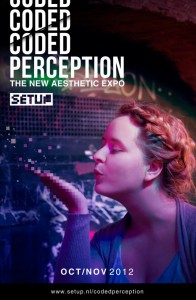 So, what is The New Aesthetic? It’s a buzzword for sure, but no one seems to be able to define it. Even the question whether it refers to an art movement, a style in design, or just simply a Tumblr-blog isn’t easily answered. SETUP Utrecht put together a small exhibition around this phenomenon and invited three speakers to help clear the picture. After an introduction by Tijmen Schep of SETUP, it was up to artist Darko Fritz, designer Frank Kloos, and researcher David M. Berry to get the discussion going.
So, what is The New Aesthetic? It’s a buzzword for sure, but no one seems to be able to define it. Even the question whether it refers to an art movement, a style in design, or just simply a Tumblr-blog isn’t easily answered. SETUP Utrecht put together a small exhibition around this phenomenon and invited three speakers to help clear the picture. After an introduction by Tijmen Schep of SETUP, it was up to artist Darko Fritz, designer Frank Kloos, and researcher David M. Berry to get the discussion going.
It all started with James Bridle’s Tumblr, followed by a much-discussed essay by Bruce Sterling. Think of portraits made out of pixels (or sculptures even), #iseefaces, but also soundscapes constructed through algorithmic software. No wait, actually it started in the 60’s, as Darko Fritz showed. The first computer art was made; multidisciplinary artists used biology, artificial intelligence and well, art, to create a new vision of reality. Now this ‘computer art’ has exploded into the new aesthetic, boasting neon colour, freaky videos and retweets. How does the computer see the world? How does it recognize humans? Interpret patterns? And how do we in turn respond to that? Tijmen Schep called it ‘painting the black box colourful again’ (but also asking whether it would not be better to actually open it) – which resonated nicely with Frank Kloos proclaiming Malevich Black Square the first (and most radical) pixel painting ever.
Translation is a key word in the talks: for example, as David Berry shows, how do computers recognize humans? And what does that say about what it means to be human? How do the different ‘languages’ translate between human and machine, machine and human and machine-to-machine? Opinions differ as to which degree humans are already machines themselves. Are we caught in algorithms, tying us down like spider webs? Has ‘computationality’ already gone so far that we cannot escape or fight back? David Berry doesn’t agree, although his account of Google’s future plans heading at ‘augmented humanity’, not only predicting but also actually replacing our innermost thoughts, definitely hits my ‘creepy line’.
The positive thing about The New Aesthetic, whether it’s an art movement, design form or empty bucket, is that the work it produces makes this tension within the computated human world visible. The big goal for a long time has been precisely to make technology invisible, with the result that we don’t realize the state of computing we actually live in. Through glitch, distorted audio, memes, datamoshing, -bending et cetera this can be again foregrounded. Moreover, it can be done in a way that doesn’t just reach the closed-in academic world or the small group of online activists, but an enormous part of the online community. Actually, everyone online helps spread the word. Or image. Or sound.
The New Aesthetic seems a truly democratic art form, but maybe it is at the same time too grand an equalizer. Is it really OK to have an art work that’s taken days, weeks, maybe months to conceptualize and construct (next to the years of education preceding the creative moment) put up next to a funny meme rolling out of a meme generator in a few seconds, on a standard Tumblr? Isn’t that contradictive to the idea of creating some kind of consciousness of the algorithms controlling us? It’s good to see theory, art, design and debate come together. So, what is this New Aesthetic thing? Open the box and have a look.
Check the book New Aesthetic, New Anxieties, written during a Book Sprint at V2, Rotterdam. And visit the exhibition Coded Perception at SETUP (until November 18).

